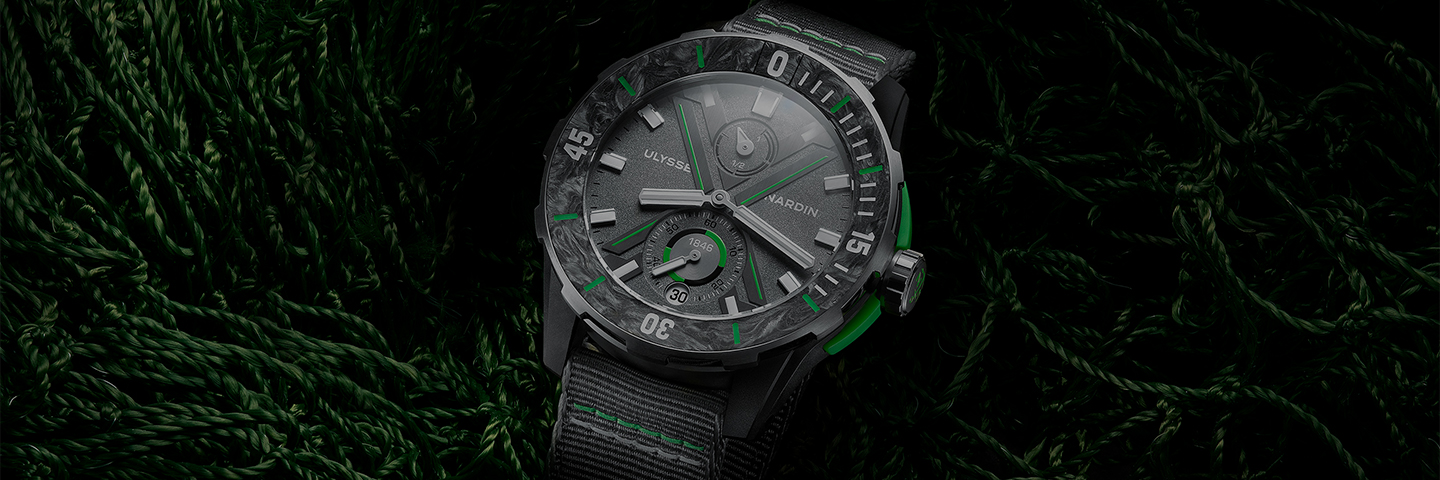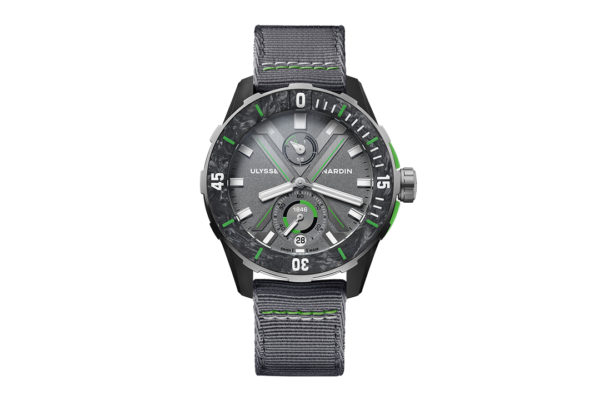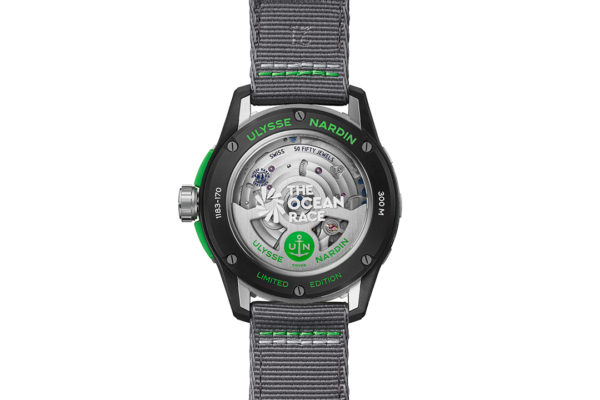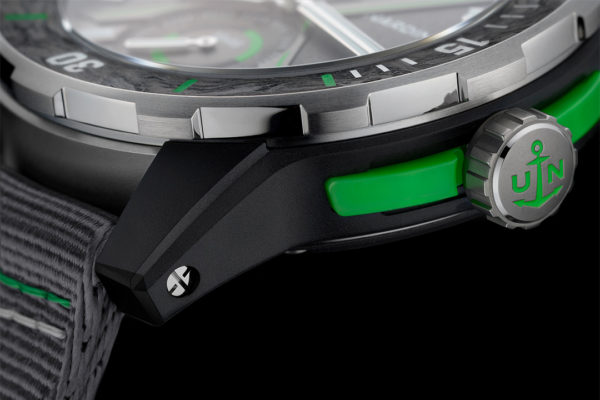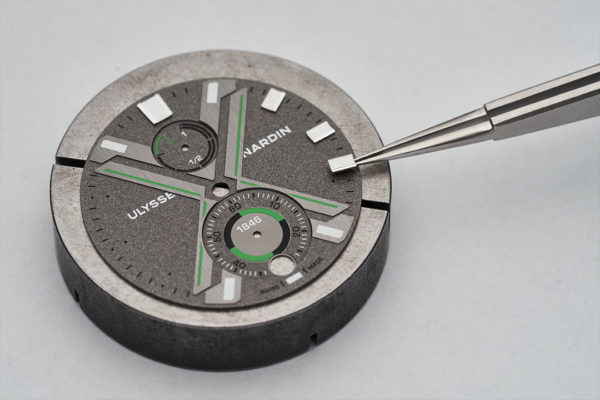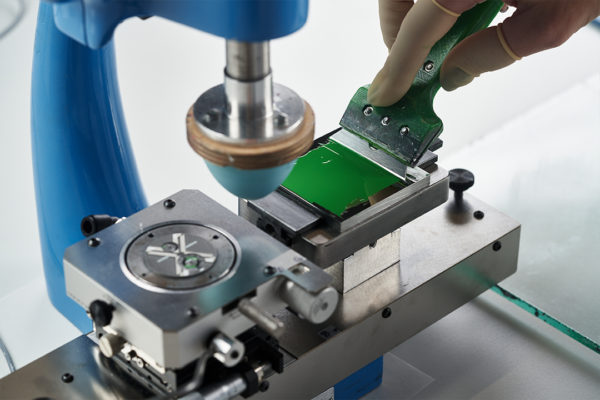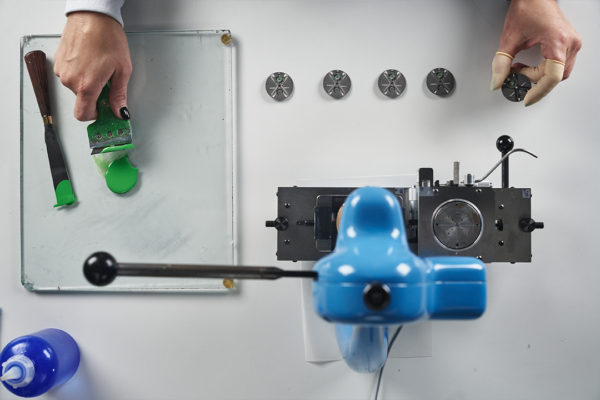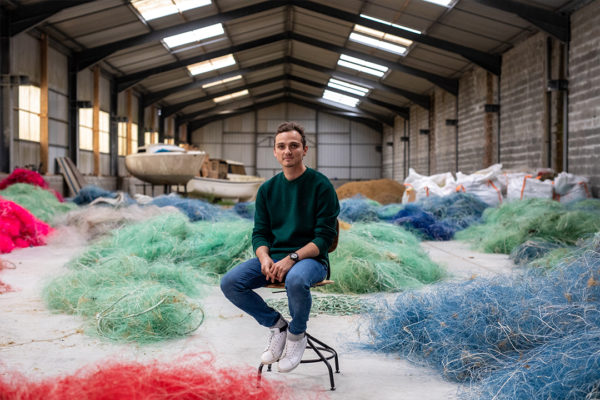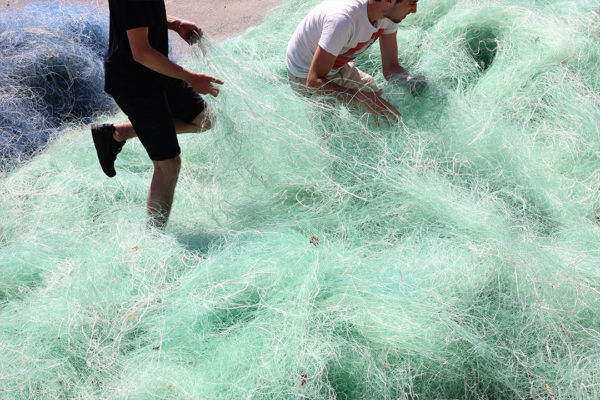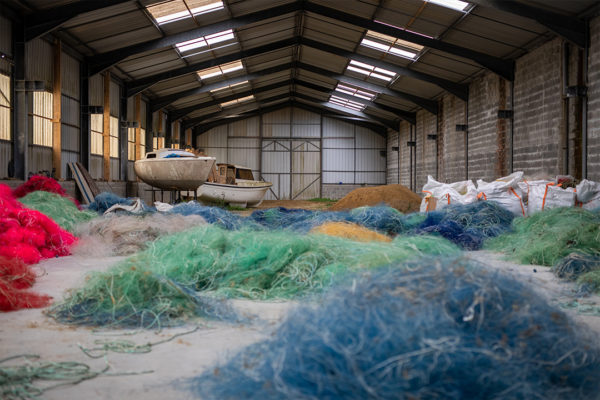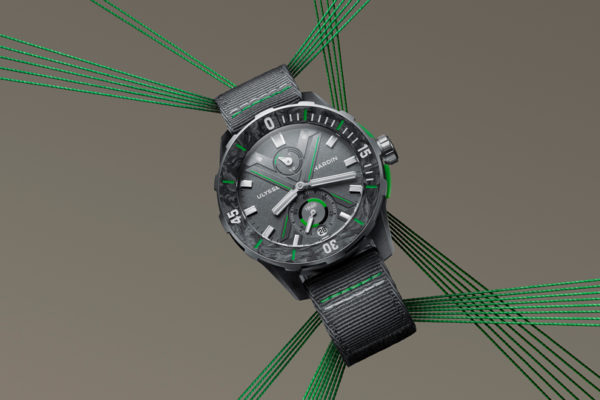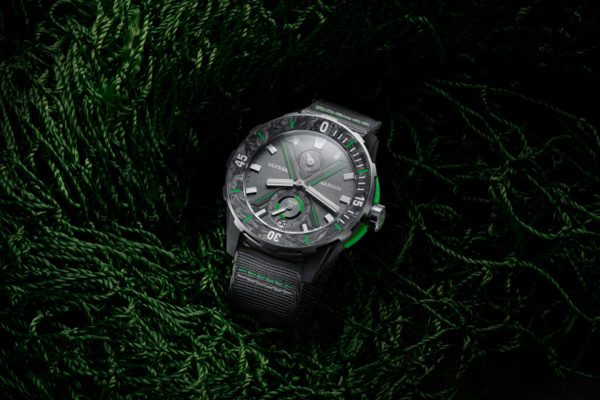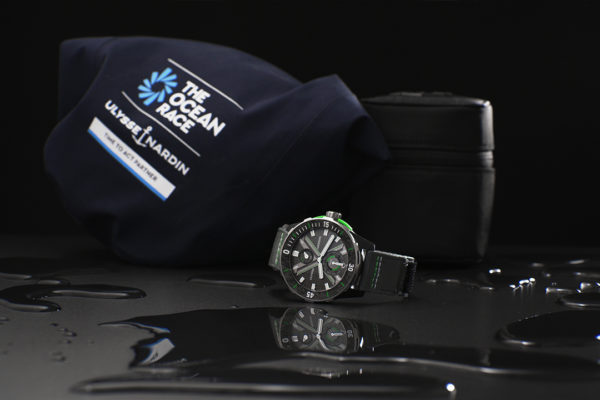Ulysse Nardin is accelerating its use of innovative alternative materials and announcing
the launch of the very first DIVER model largely composed of recycled fishing nets:
THE OCEAN RACE DIVER
Ulysse Nardin and The Ocean Race are seeing their shared commitment realized with THE OCEAN RACE DIVER, which will be the official timekeeper for the open-sea sailing race scheduled to start from Alicante, Spain, on January 15, 2023. With this new sophisticated and environmentally friendly watchmaking creation, the two partners are making a pledge to protect the Ocean and start the countdown for positive results by 2030.
Le Locle, May 17, 2022
THE OCEAN RACE DIVER: FROM THE OCEAN, FOR THE OCEAN
The beginning of a new era for Ulysse Nardin.
The Swiss watchmaker has been making marine chronometers of incomparable reliability for explorers since 1846. Today’s navigators are inevitably confronted with plastic pollution, with 5,000 billion pieces floating at sea Fishing nets (mainly made of polyamide) are one of the main sources of this Ocean plastic pollution: up to 640,000 metric tons are lost or abandoned each year (UN) joining the nine million metric tons of plastic discharged into the sea (Science).
“How can we transform some of this plastic into a luxury item? With the help of start ups such as FIL&FAB, we have successfully managed to fabricate and sell watches derived from recycled fishing nets,” announced Patrick Pruniaux, CEO of Ulysse Nardin
This effort was praised by Peter Thomson, the United Nations’ Special Envoy for the Ocean, during a meeting at the world congress of the IUCN in Marseille in September 2021: “Drifting fishing nets are a huge part of the problem of plastic pollution. They are very destructive for marine life such as corals and turtles. The fact that you are upcycling them is positive, as there are far too many of them in the Ocean.”
“Our way of making people aware of the issue is upcycling In this process, finding suppliers was a key factor,” confirms Patrick Pruniaux.
In September 2020, Ulysse Nardin marked the first milestone in its commitment to the circular economy in favor of the sea with the launch of the R-STRAP wrist strap which is made entirely from recycled fishing nets and can be used with MARINE, DIVER and FREAK X watches.
Then in November 2020, the brand innovated with the DIVER NET, an experimental concept watch, each element of which was designed for durability, to be as environmentally friendly as possible. A totally innovative and upcycled watch. Two considerable positive advances for the brand and the watchmaking industry.
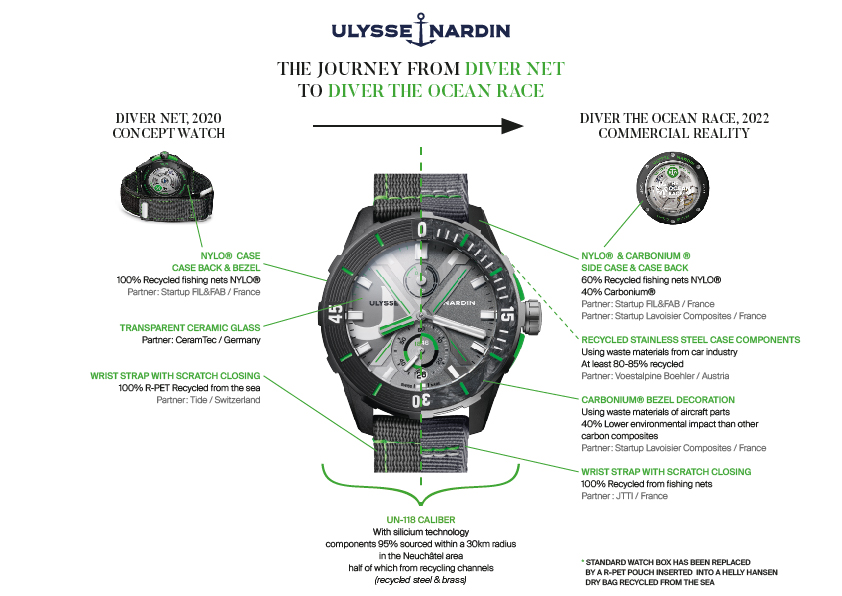
From The Design Project To The Commercialized Object
Always keeping its promises…
The brand had promised to move quickly from concept to marketing. In June 2022, the diving watch made from recycled fishing nets will become the first sustainable luxury watch to be put on the market and offered in a limited edition of 200 pieces. It confirms the global trend of the luxury sector towards upcycling, already adopted by the high fashion industry. The goal is to raise awareness by creating “new from old” and regenerating materials, especially plastic. Ulysse Nardin is conclusively making the change towards the circular economy with this movement of regeneration of nets. Thanks to the work of the French start-up FIL&FAB, the brand thus puts the spotlight on a “less noble” material enhanced by a “100% Manufacture” watchmaker’s approach, making the object as desirable as if it were designed in a more conventional material than polyamide.
The Watch’s Characteristics
Ulysse Nardin’s designers meticulously decorated the watch, water-resistant up to 300 m, with touches of bright green, a reflection of nature. These are everywhere: from the stitching on the strap to the markers and bezel, including the “double X” signature of the dial, the power reserve indicator at midday, the small seconds hand at 6 o’clock, the Ulysse Nardin logo etched onto the crown, the crown protector, and the individual plate. A combination of white, gray and black completes the color palette of the watch, which beats to the rhythm of the Manufacture’s iconic movement, the UN-118, with its silicium technology.
The components of this movement are 95% sourced within a 30 km radius of the Manufacture, half of them coming from recycling channels (recycled steel and brass in particular: 100% of Ulysse Nardin movements make use of recycled brass). THE OCEAN RACE DIVER embodies innovation and tradition, since its movement retains its historical know-how. The caliber of a watch of this quality being by nature a sustainable product since it works on wrist power.
The dial is more toned down than the concept version of the DIVER NET even if there is still an obvious parenthood: the white U and N initials in extra-large capital letters have disappeared to make way for a neutral textured anthracite (ruthenium) surface treatment. The iconic double X is still in its place, stamped on the dial with its half-matt half-satin finish.
On the case back, the sapphire crystal is embellished with a white transfer of the logo of the brand’s partner, The Ocean Race.
A Bezel Decoration Designed in Carbonium®
The unidirectional bezel is entirely decorated with Carbonium® (Lavoisier Composites). Carbonium® is made of the same fibers that are used for the fuselage and wings of the latest-generation aircrafts. The manufacture of Carbonium® has a 40% lower environmental impact than other carbon composites, since it makes use of the offcuts of aircraft parts. Created using a complex process under high pressure at high temperature, Carbonium® is a high-performance material that reveals the inner beauty of the organic pattern formed by carbon fibers that have a diameter of only 7 µm. The use of such a regenerated material again clearly underlines the brand’s spirit of boldness and innovation. In fact, in 2019 Ulysse Nardin was the first watchmaking brand to use this new material in a watch. Its strength-to-lightness ratio is incomparable and its superb marbling effect makes each case an absolutely unique piece.
A Case Designed With Two Principle Materials: NYLO® + Carbonium® (60% + 40%) and Steel At Least 80-85% Recycled
The side-case and case-back of the 44 mm THE OCEAN RACE DIVER’s are the result of an interesting combination of materials: 40% Carbonium® (Lavoisier Composites) and 60% polyamide recycled from fishing nets, Nylo® (FIL&FAB). Ulysse Nardin has placed its trust in young Breton designers who have created the very first fishing net recycling business in France. FIL&FAB, a start-up in the field of industrial design and transition, recovers disused nets in French fishing ports and recycles them in the form of polyamide granules called Nylo®.
Building on this 360° upcycling virtuous spiral, Ulysse Nardin’s engineering office teams have taken their eco-responsible approach further and selected a type of recycled steel for certain watch case components, at least 80% recycled where the case back is concerned. The renowned Austrian steelworks of Voestalpine Boehler, a supplier of the brand, has embarked on a process of comprehensive sustainable transformation and is actively focusing its efforts on supplying its watchmaking customers with very high-quality steel, guaranteed recycled and soon to be guaranteed upcycled. Thus, the steel that adorns part of THE OCEAN RACE DIVER, 80 to 85% recycled, comes from an automotive industry steel recycling channel.
A Strap 100% Made of Recycled Fishing Nets
The strap with scratch closing is also fully recycled from fishing nets, transformed into reels of yarn by the French company JTTI.
A Pack 100% Made of Recycled Plastic From The Sea
From June 2022, THE OCEAN RACE DIVER will be sold in an original pack: a water-resistant R-PET pouch slipped into a dry bag recycled from the sea by Helly Hansen, a brand that is also a partner of the round-the-world race as the official clothing supplier, at a price of CHF 10,900.
Freaky Facts
• Every year, nine million metric tons of plastic are dumped into the sea. (Science)
• 350 million metric tons of plastic are produced every year. (UN)
• 640,000 metric tons of fishing nets are lost or abandoned every year. (UN)
• Abandoned fishing nets kill nearly 100,000 whales, dolphins, sea lions, seals and turtles per year. (World Animal Protection)
• Turtles confuse plastic bags with jellyfish and ingest them. (Indicit)
• 80% of seabirds ingest plastic. (PNAS)
• Microplastic is found on mountain tops, proving that the material has entered the cycle of the elements: evaporated nanoparticles end up in the clouds and as a result it snows plastic (Nature Geoscience)
• 2/3 of the plastic discharged into the ocean since the 1950s has washed up on the shores; 1/3 has degraded into microplastic. (Scientific Reports)
• Microplastics account for 90% of the 5,000 billion pieces of plastic floating on the ocean surface. (Tara Océan)
• A large conveyor belt crosses the Ocean: it takes a drop of water a thousand years to return to the same place. (NOAA)
• A shipment of 29,000 plastic ducks accidentally lost in the Pacific in 1992 proved useful to oceanographers, who tracked them for 25 years. (The Friendly Floatees)


